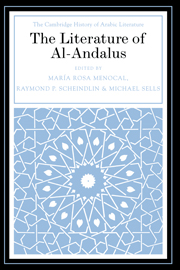Book contents
- Frontmatter
- 1 Visions of al-Andalus
- PART I THE SHAPES OF CULTURE
- PART II THE SHAPES OF LITERATURE
- PART III ANDALUSIANS
- PART IV TO SICILY
- 20 Poetries of the Norman courts
- 21 Ibn Ḥamdīs and the poetry of nostalgia
- 22 Michael Scot and the translators
- Mudejar Teruel and Spanish identity
- PART V MARRIAGES AND EXILES
- PART VI TO AL-ANDALUS, WOULD SHE RETURN THE GREETING
- Index
Mudejar Teruel and Spanish identity
from 22 - Michael Scot and the translators
Published online by Cambridge University Press: 28 May 2012
- Frontmatter
- 1 Visions of al-Andalus
- PART I THE SHAPES OF CULTURE
- PART II THE SHAPES OF LITERATURE
- PART III ANDALUSIANS
- PART IV TO SICILY
- 20 Poetries of the Norman courts
- 21 Ibn Ḥamdīs and the poetry of nostalgia
- 22 Michael Scot and the translators
- Mudejar Teruel and Spanish identity
- PART V MARRIAGES AND EXILES
- PART VI TO AL-ANDALUS, WOULD SHE RETURN THE GREETING
- Index
Summary
While the shift from Muslim to Christian rule in Aragon in the twelfth century was a major political upheaval, the identity and religion of the resident population remained relatively static due to protective royal edicts that guaranteed rights such as the practice of religion and freedom of movement. Thus, in 1365, approximately 235,000 Mudejares (Muslims under Christian rule) still lived in Aragon. Despite plague, emigration, and conversion, even as late as the fifteenth century a census documented a Muslim population of 11 percent in Aragon and 10 percent in the city of Teruel.
The Mudejares were skilled in construction and built several churches in Teruel, of which the remains of four survive. Santa María Mediavilla, which dates to 1342, replaced an earlier Romanesque church to which a Mudejar tower was attached in 1258. The tall, rectangular, brick tower that spans the street is decorated with panels of interlacing arches, bricks set in a saw tooth pattern, framed ajimez (paired) windows, and green and white glazed tile that was the specialty of the Mudejar potters of Teruel. The Tower of San Martín was built in 1315 in the area that had been the intra-muros Muslim quarter after the conquest. It too consists of a tall rectangular block arching over the street, ornamental brickwork, and glazed ceramics. The surface of the majestic tower is crisply textured, colorful, and gleams in the sunlight.
- Type
- Chapter
- Information
- The Literature of Al-Andalus , pp. 413 - 414Publisher: Cambridge University PressPrint publication year: 2000



